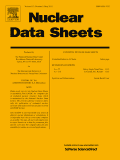
NUCLEAR DATA SHEETS
metrics 2024
Unveiling the Universe: Data-Driven Insights in Nuclear Physics.
Introduction
NUCLEAR DATA SHEETS is a premier journal published by Academic Press Inc. Elsevier Science, dedicated to advancing the field of nuclear and high-energy physics. With an impressive impact factor and a distinguished Q2 ranking in the pertinent category as of 2023, this journal is recognized for its significant contributions to the synthesis and dissemination of nuclear data, serving as an essential resource for researchers, professionals, and students alike. The journal has been in continuous publication since 1971, making it a cornerstone of knowledge in the discipline as it converges into 2024. Researchers can explore a plethora of meticulously curated articles that cover the latest findings, theoretical advancements, and experimental results in nuclear data, with the objective of fostering collaboration and innovation within the scientific community. While currently not open access, its publications are accessible through institutional subscriptions, ensuring a wide reach amongst academic and research institutions worldwide. With a high Scopus rank of #10 out of 87 in its field, NUCLEAR DATA SHEETS remains an authoritative source that is instrumental in shaping the future of nuclear physics research.
Metrics 2024
 0.78
0.78 2.80
2.80 10.10
10.10 68
68Metrics History
Rank 2024
Scopus
IF (Web Of Science)
JCI (Web Of Science)
Quartile History
Similar Journals
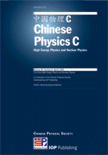
Chinese Physics C
Fostering Innovation in Experimental MethodologiesChinese Physics C is a premier, peer-reviewed journal published by IOP Publishing Ltd, dedicated to advancing knowledge in the fields of Astronomy and Astrophysics, Instrumentation, and Nuclear and High Energy Physics. With an impressive impact factor reflecting its standing in the Q1 quartile across multiple categories, this journal serves as a vital resource for researchers, professionals, and students seeking to engage with cutting-edge developments and experimental findings. Since its inception in 2008, Chinese Physics C has fostered significant collaborations and discussions within the global physics community, enabling easy access to high-quality research through its open access options. Operating from the United Kingdom with a commitment to excellence, this journal not only showcases high-impact papers but also encourages innovative methodologies and interdisciplinary approaches, solidifying its role as an essential platform for dissemination and dialogue in the rapidly evolving landscape of physics.
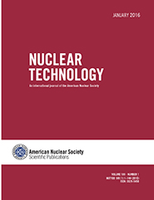
NUCLEAR TECHNOLOGY
Leading the Charge in Nuclear Research ExcellenceNUCLEAR TECHNOLOGY is a leading academic journal published by TAYLOR & FRANCIS INC, dedicated to the expansive field of nuclear science and engineering. With a robust ISSN of 0029-5450 and an E-ISSN of 1943-7471, this journal provides invaluable insights and cutting-edge research from 1971 to 2024. Positioned in the esteemed Q2 category for Condensed Matter Physics, Nuclear and High Energy Physics, and Nuclear Energy and Engineering, it boasts respectable Scopus rankings, underscoring its impact and relevance within the academic community. NUCLEAR TECHNOLOGY serves as a crucial platform for researchers, professionals, and students, fostering an exchange of knowledge that advances the understanding and application of nuclear technologies. While it operates on a subscription model, this journal remains a vital resource for those aiming to contribute to or stay at the forefront of developments in nuclear technology.
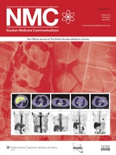
NUCLEAR MEDICINE COMMUNICATIONS
Pioneering Techniques for Enhanced Imaging and TreatmentNUCLEAR MEDICINE COMMUNICATIONS is a prestigious academic journal published by Lippincott Williams & Wilkins, focusing on the multifaceted field of nuclear medicine and its applications in diagnostics and therapy. With a solid history spanning from 1980 to 2024, this journal provides a platform for peer-reviewed research articles, clinical studies, and innovative techniques that enrich the knowledge base within the fields of {{medicinal applications, patient care, and imaging technology}}. Currently classified in the Q3 quartile for both Medicine (Miscellaneous) and Radiology, Nuclear Medicine, and Imaging, the journal reflects its commitment to advancing healthcare practices. Although it does not offer open access options, its accessibility through reputable institutions promotes scholarly exchange among researchers, professionals, and students alike. The critical insights provided in NUCLEAR MEDICINE COMMUNICATIONS are essential for those dedicated to enhancing patient outcomes through cutting-edge nuclear medical technologies.
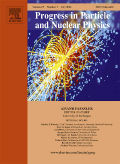
PROGRESS IN PARTICLE AND NUCLEAR PHYSICS
Advancing Knowledge in High Energy PhysicsPROGRESS IN PARTICLE AND NUCLEAR PHYSICS is a prestigious academic journal published by Elsevier, focusing on the dynamic fields of particle and nuclear physics. Established in 1978 and continuing through 2024, this journal is recognized for its significant contributions to the scientific community, holding a Q1 ranking in Nuclear and High Energy Physics and topping the Scopus ranking in its category. With an impactful platform that encourages the dissemination of groundbreaking research, it attracts a diverse readership of researchers, professionals, and students eager to explore the latest advances in these fields. The journal is headquartered in Amsterdam, Netherlands, and provides an essential resource for those seeking to understand complex phenomena in particle and nuclear science. Although it does not offer Open Access options, it continues to uphold a reputation of excellence and rigor, making it a vital source of information in its domain.

EUROPEAN PHYSICAL JOURNAL A
Pioneering High Energy Physics Research and CollaborationEUROPEAN PHYSICAL JOURNAL A (EPJ A), published by Springer, is a premier journal in the field of Nuclear and High Energy Physics, dedicated to fostering innovative research and scholarly communication within the scientific community. With an impressive impact factor that reflects its significant contribution to the discipline, EPJ A ranks in the Q1 category and boasts a Scopus rank of 24 out of 87, placing it in the 72nd percentile of its field for 2023. This journal, with its ISSN 1434-6001 and E-ISSN 1434-601X, embraces a commitment to open access, ensuring that cutting-edge research is accessible to a global audience. With coverage from 1998 to 2024, EPJ A continues to be a vital resource for researchers, professionals, and students alike, promoting collaboration, knowledge sharing, and advancements in the vast landscape of nuclear physics and high-energy interactions. Located in Germany with a representative address in New York City, this journal serves as a bridge for international scientific discourse.
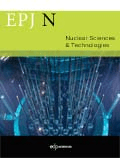
EPJ Nuclear Sciences & Technologies
Exploring the Future of Nuclear Science and EngineeringEPJ Nuclear Sciences & Technologies is a prominent Open Access journal published by EDP Sciences S A, focusing on the vital fields of Nuclear and High Energy Physics, Nuclear Energy and Engineering, and Energy Engineering and Power Technology. Launched in 2015, this journal provides a platform for researchers, students, and professionals to disseminate cutting-edge research and innovations that address the challenges and opportunities in nuclear sciences, a field of critical importance in today’s energy landscape. With an ISSN of 2491-9292 and an evolving impact reflected in its 2023 Q3 quartile rankings across several relevant categories, EPJ Nuclear Sciences & Technologies is committed to promoting high-quality, peer-reviewed research accessible to a global audience. Its dedicated focus on enhancing knowledge transfer and international collaboration makes it an essential resource for anyone engaged in nuclear sciences and technologies.

Journal of Condensed Matter Nuclear Science
Unveiling New Perspectives in Nuclear Science and Physics.The Journal of Condensed Matter Nuclear Science, published by the International Society for Condensed Matter Nuclear Science in the United Kingdom, serves as a pivotal platform for researchers exploring the intersections of condensed matter physics and nuclear science. With an ISSN of 2227-3123, this journal has been actively contributing to the academic discourse from its inception in 2016 through its latest volume in 2022. Although classified in Q4 quartiles across various categories, including Atomic and Molecular Physics, Condensed Matter Physics, and Nuclear Energy and Engineering, the journal provides a unique lens on innovative approaches and perspectives that could significantly impact future research directions. This open-access journal appeals to an audience keen on investigating the theoretical and experimental aspects of condensed matter nuclear science, fostering a collaborative environment for scientists, engineers, and students alike. By advancing discussions in this niche field, it aims to attract attention and inspire groundbreaking discoveries that underpin the evolving landscape of nuclear energy and applications.
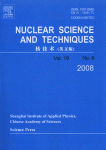
Nuclear Science and Techniques
Connecting Researchers to the Heart of Nuclear InnovationNuclear Science and Techniques is a distinguished peer-reviewed journal published by Springer Singapore Pte Ltd, dedicated to advancing the fields of nuclear science and engineering. With an impressive impact factor reflected in its 2023 quartile rankings—Q2 in Nuclear and High Energy Physics and Q1 in Nuclear Energy and Engineering—the journal serves as a vital resource for researchers, professionals, and students alike. Covering a breadth of topics from nuclear physics to energy applications, it offers a platform for innovative research and developments in the nuclear domain. The journal, indexed under ISSN 1001-8042 and E-ISSN 2210-3147, aims to foster scientific exchange and collaboration within the community by publishing high-quality articles that contribute significantly to the field. Committed to maintaining an open-access ethos, it enhances visibility and accessibility of critical knowledge, making it an essential source for current insights and trends in nuclear science.

PHYSICS OF PARTICLES AND NUCLEI
Fostering Dialogue in Nuclear SciencePhysics of Particles and Nuclei is an esteemed journal within the field of nuclear and high energy physics, published by Pleiades Publishing Inc. Based in the United States, this journal has been a vital platform for disseminating cutting-edge research since its inception in 1996, with coverage extending until 2024. Indexed under the ISSN 1063-7796 and the E-ISSN 1531-8559, it has established itself as a noteworthy publication, currently categorized in the Q3 quartile according to the 2023 standards for Nuclear and High Energy Physics. With its Scopus ranking placing it at #62 out of 87 in its category, Physics of Particles and Nuclei provides unique insights and discussions that resonate with academics, researchers, and students alike. Although it does not offer open access, the journal continues to serve as a crucial resource for those looking to engage deeply with the latest advancements and theoretical explorations in particle and nuclear physics.
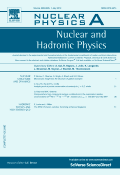
NUCLEAR PHYSICS A
Driving Progress in High Energy Physics ResearchNUCLEAR PHYSICS A, published by Elsevier, is a leading international journal dedicated to the fields of Nuclear and High Energy Physics. With an ISSN of 0375-9474 and E-ISSN 1873-1554, the journal has been pivotal in advancing research since its inception in 1967 and is set to continue influencing the discipline through 2025. It holds a commendable Q2 classification in the 2023 category of Nuclear and High Energy Physics, ranking 32nd out of 87 journals in its field according to Scopus, placing it in the 63rd percentile. NUCLEAR PHYSICS A provides valuable insights and disseminates cutting-edge research, aiding researchers, professionals, and students in their academic and practical pursuits. Though it does not currently offer open access, the journal remains a vital resource for those engaged in the exploration of nuclear phenomena and theoretical advancements in high-energy physics.